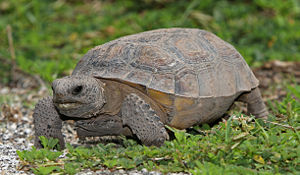Gopher tortoises
| Gopher tortoises | ||||||||||||
|---|---|---|---|---|---|---|---|---|---|---|---|---|

|
||||||||||||
| Systematics | ||||||||||||
|
||||||||||||
| Scientific name | ||||||||||||
| Gopherus | ||||||||||||
| Rafinesque , 1832 |
The gopher tortoises ( Gopherus ) are a species of tortoise belonging to the tortoise family . Their range is limited to southern North America. According to new genetic studies, the closest related genus is the Asian forest turtle ( Manouria ) that occurs in Asia .
Appearance
Adult gopher tortoises reach a carapace length of up to 40 centimeters and can weigh up to four kilograms. Their front legs are flattened and heavily scaled, which makes digging in the ground easier.
Distribution area and habitat
The gopher tortoises are limited in their range to the south of North America. They occur in the USA from the California Mojave Desert to Florida as well as in the northern part of Mexico . The yellow-tinged gopher tortoise , which was only scientifically described in 1959, is even limited in its distribution to the small area of the Chihuahua desert in the Mexican state of Durango .
Their habitat is arid areas and the edge of deserts. They have adapted to the high temperatures of their habitat through several strategies. They are crepuscular and they are able to dig burrows that can reach a length of up to 12 meters and a depth of up to 3 meters. They spend most of the day in these burrows. The depth and length of the building depend on the temperatures in their habitat. A number of other animal species also use these burrows as caves. Because of this, gopher tortoises play a major role in their respective ecosystems.
Way of life
Gopher tortoises mainly eat plant-based food. This includes grass and legumes. Their food plants also include small berries, fruits. They also eat carrion and the excrement of mammals. Gopher tortoises rarely drink. Most of the water they need is ingested through their food. The mating season of the gopher tortoises falls from April to May. A clutch usually contains between three and fifteen eggs. The period of time that elapses until the hatchlings are between 70 and 100 days and depends, among other things, on the ambient temperature. The animals reach sexual maturity at an age of ten to fifteen years.
Duration
Gopher tortoises are strictly protected in their range because they are considered an endangered species. The main cause of the threat is habitat loss. For this reason, this genus of tortoise hardly plays a role in keeping the terrarium.
species
6 species are included in the genus:
- California gopher tortoise ( Gopherus agassizii ( Cooper , 1863))
- Texas gopher tortoise ( Gopherus berlandieri ( Agassiz , 1857))
- Gopherus evgoodei Edwards, Karl, Vaughn, Rosen, Meléndez-Torres & Murphy, 2016
- Yellow-tipped gopher tortoise ( Gopherus flavomarginatus Legler , 1959)
- Sonoran gopher tortoise ( Gopherus morafkai Murphy, Berry, Edwards, Leviton, Lathrop & Riedle, 2011)
- Georgia gopher tortoise ( Gopherus polyphemus ( Daudin , 1802))
proof
Individual evidence
- ↑ M. Le, CJ Raxworthy, WP McCord, L. Mertz: A molecular phylogeny of tortoises (Testudines: Testudinidae) based on mitochondrial and nuclear genes . In: Molecular Phylogenetics and Evolution . tape 40 , May 5, 2006, pp. 517-531 , doi : 10.1016 / j.ympev.2006.03.003 .
- ^ Gopher Tortoise Council
- ↑ Rogner, p. 84.
- ^ The Gopher Tortoise Organization
- ↑ uga.edu ( Memento of the original from October 9, 2007 in the Internet Archive ) Info: The archive link was inserted automatically and has not yet been checked. Please check the original and archive link according to the instructions and then remove this notice.
literature
- Manfred Rogner: Tortoises - biology, keeping, reproduction. Eugen Ulmer, Stuttgart 2008, ISBN 978-3-8001-5440-1 .
